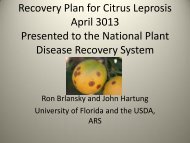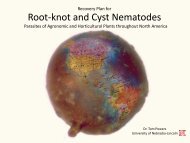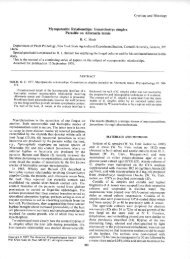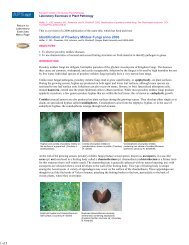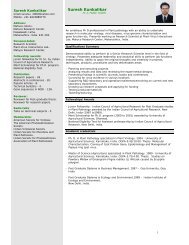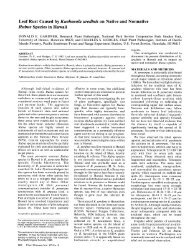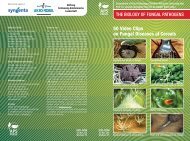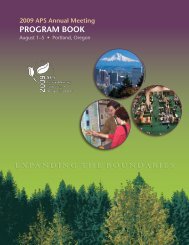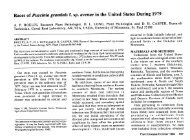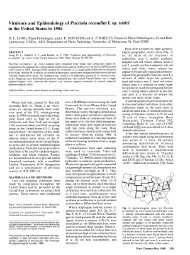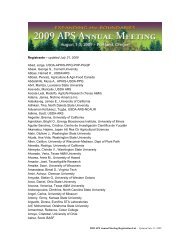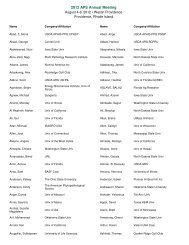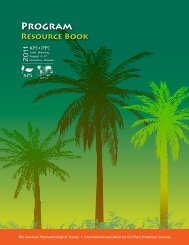view article - American Phytopathological Society
view article - American Phytopathological Society
view article - American Phytopathological Society
Create successful ePaper yourself
Turn your PDF publications into a flip-book with our unique Google optimized e-Paper software.
244 Factors were studied that limited take-all development on<br />
wheat following sorghum in doublecropping systems. Two<br />
CORRELATION OF ARMILLARIA ROOT ROT WITH DAMAGE TO TREES field studies with plots exhibiting decreased take-all<br />
DEFOLIATED BY THE JACK PINE BUDWORM. K.I. Mallett and W.J.A. severity following sorghum had lower soil pH than plots<br />
Volney. Forestry Canada, Northern Forestry Centre, 5320 - 122 where wheat followed soybean. Bioassays for microbial<br />
St. Edmonton, Alberta, Canada T6H 3S5 suppressiveness indicated wheat:sorghum doublecropped soils<br />
were suppressive to take-all at levels similar to soils with<br />
Pinus banksiana trees severely defoliated by the jack pine long histories of wheat monoculture. Growth chamber studies<br />
budworm (Choristoneura pinus) in 1985 and '86 were dissected to indicated no differences in disease development on wheat in<br />
determine the extent of root infections by Armillaria sp. The artificially infested soils after amending with various<br />
severity of damage to the tree crowns was correlated with the summer crop residues, including sorghum, or planting with<br />
incidence of root infection: 100 % of the dead trees were these summer crops, indicating no differences in pathogen<br />
infected with Armillaria sp., 60% of the trees whose upper survival.<br />
crowns had been killed were infected, but only 20% of the<br />
healthy trees were infected. The value of these observations<br />
in hazard-rating jack pine stands is discussed. 249<br />
RHIZOSPHERE COMPETENCY OF FIVE Fusarium SPECIES ON MAIZE PLANTED<br />
245 IN THE FIELD. C. M. Ocamb, T. Kommedahl, and P. M. Burnes,<br />
Department of Plant Pathology, University of Minnesota, St.<br />
VARABILITY IN VM CE OF OOSPORE INOCUIUM OF 1HYflJORA Paul, MN 55108.<br />
CAPSICI AND THE RELATIONSHIP OF ME DENSITY OF OOSPORES IN<br />
SOIL TO PI I4JTAMFLI. J.H. Bowers and D.J. Mitchell. Dept. In 1988, maize seeds were coated with one of five species of<br />
of Plant Pathology, Univ. of Florida, Gainesville, FL 32611. Fusarium and planted in the field. Virtually the entire root<br />
systems of the seedlings were colonized by each of three<br />
Oospore progeny from 20 crosses of pathogenic isolates of species. Of these, F. moniliforme constituted 90%; E.<br />
Phytophthora capsici were found to vary in pathogenicity to proliferatum, 48%; and F. oxysporum, 39% of the colonies<br />
pepper. Only oospore inoculum from specific crosses caused isolated from roots. Seedling root systems were not extensively<br />
disease in pepper seedlings with an initial inoculum density colonized by F. solani (9%) or F. equiseti (11%). The seedling<br />
of 25 oospores per gram of soil. The highest mortality (30 to root systems of the dry control, water control, and the captan<br />
75%) resulted fra oospore inoculum produced from crosses in- treatment yielded primarily F. oxysporum and F. solani.<br />
volving certain isolates of A2 compatibility type. Oospore Rhizosphere competence differed in laboratory, greenhouse, and<br />
inoculum from other crosses caused little or no disease (0 to field tests. Field studies offer evidence that Fusarium species<br />
5%). Oospores produced from one cross resulted in 40 and 60% present in the seed differ as potential inoculum sources for<br />
plant mortality with inoculum densities of 10 and 15 oospores root infections.<br />
per gram of soil, respectively. The ID50 was calculated to be<br />
41 oospores per gram of soil. Inoculum efficiency was calculated<br />
using the multiple infection transformation as the<br />
estimated number of infections per propagule and was found to 250<br />
be 0.011. EFFECT OF INOCULUM DENSITY OF CEPHALOSPORIUM GRAMINEUM AND SOIL<br />
pH ON CEPHALOSPORIUM STRIPE OF WINTER WHEAT. L. P. Specht and<br />
246<br />
T. D. Murray. Department of Plant Pathology, Washington State<br />
University, Pullman, WA 99164-6430.<br />
SURVIVAL OF FUSARIUM OXYSPORUM F. SP. VASINFECTUM IN<br />
SOIL AS AFFECTED BY FOUR CROPPING SYSTEMS. J. P, McEntee,<br />
R. D. Martyn, and J. L. Starr. Department of Plant Pathology and<br />
Microbiology, Texas A&M University, College Station, 77843.<br />
Winter wheats (cvs. Stephens and Nugaines) were grown in soil<br />
adjusted to pH values of 4.5-7.6 and maintained at -0.01 MPa.<br />
Soil in pots was drenched with conidial suspensions of Cephalosporium<br />
gramineum when seedlings were in the four- to five-l<br />
Microplots infested with a sand:cornmeal inoculum of Fusarium<br />
oxysporum f. sp. vasinfectum (FOV) were planted with a FOVsusceptible<br />
cotton cultivar (Rowden), a resistant cultivar (Auburn 634),<br />
a nonhost (Sorghum), or left fallow. Populations of FOV were<br />
determined initially and again at mid- and end-of-season. At the end<br />
of the season, plants were examined for vascular browning (VB) and<br />
isolation frequency of FOV from root and stem tissue. Final FOV<br />
populations were highest in microplots planted to sorghum, while no<br />
difference was observed between FOV populations from Rowden and<br />
Auburn 634. The fallow treatment had the lowest FOV populations.<br />
Differences in plant numbers with VB and in the nature of the VB<br />
were observed between cotton cultivars. VB incidence and severity was<br />
greatest in Rowden; however, no significant difference in isolation<br />
frequency of FOV was observed between cultivars. Examination of the<br />
sand:cornmeal inoculum revealed that it was composed largely of<br />
microconidia, chlamydospores and mycelia. When dried under sterile<br />
conditions, the microconidial and mycelial populations decreased<br />
rapidly, leaving primarily chlamydospores.<br />
stage. Inoculum density of C. gramineum, soil pH, and cultivar<br />
h "<br />
'<br />
all had significant (P



